Manual Kit Listing
This listing is for pools that don't have independent solar suction and return lines and must have solar running through their main filter systems. If you have solar provisions, see "Independent" listings.
What's Included in This Listing
For Every OKU Panel Purchased
- Reinforced silicon joiner set
- All stainless steel band clamp set
- PVC coated 316 stainless steel strap set
For Every Manual System Purchased
- 1 x 40mm PVC non-return valve
- 1 x 40mm PVC 3-way valve
- 40mm hose to PVC glue socket adapters
- Fast opening vacuum release valve
- Comprehensive installation manual
- Warranty from an Australian company which stocks spare parts
- Unlimited technical support
For more information the manual can be downloaded from our EcoOnline download page.
What You'll Need for an Install
- Aluminium angle to mount collectors
- Solar roof hooks (for tiles; contact us for sizing)
- Assorted PVC pipe and fittings
- Installation dependent small bits (see manual)
Warranty
EcoOnlineTM offers the following Warranties on system components:
- 35 year return to base limited Warranty on OKU collectors
See Terms and Conditions page for further details.








EcoOnline Performance+TM OKU Solar Pool Heater Systems
The EcoOnline Performance+TM OKU solar pool heating systems come with premium German made collector panels designed and adapted for Australian conditions to be the best overall pool heating systems in Australia bar none.
These newly redesigned Performance+TM panels come with an extraordinary industry first 35 Year Warranty. They are made from ultra-durable (UV stabilized) potable grade HDPE - an outstanding material with proven longevity and a very long industry pedigree in the harsh Australian sun. They are made extremely tough and are resistant against all that nature can throw at them.
The quality of these panels along with EcoOnline's exclusive fittings and fixings made from the most durable of materials, such as silicon and stainless steel, our attention to the smallest details and the precision engineering of all components - make for an unbeatable combination of efficiency, quality and longevity.

Advantages of the EcoOnline Performance+TM Systems
Importance of Cooler Weather Efficiency
Traditional PVC tubular collectors work okay in hot weather and various manufacturers will play up hot weather performance stats, however due to the spherical and almost fin like nature of the collector they struggle in cooler windy spring and autumn shoulder months - which is exactly when you need heating the most! OKU panels were originally designed for the cooler German climate and are optimized to perform in these shoulder months. As such they typically require much less area than traditional rubber mat systems to effectively extend your swimming season since it's really the performance in the shoulder months that matters most for extending your season. Consider the following design comparison during cooler windy spring and autumn conditions:

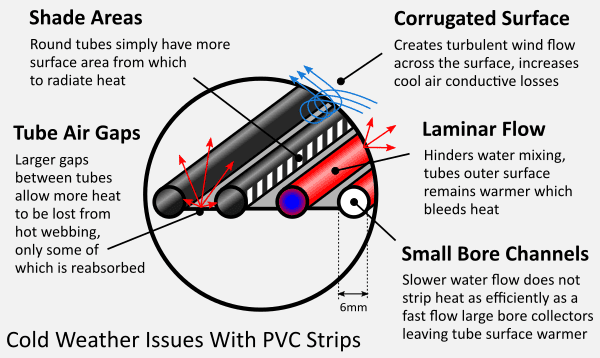
As can be seen - a flat face, large open bore collector with little to no air gaps (hot spots) and with turbulent water mixing - is simply as close to the maximum possible theoretical efficiency limit you can get.* The only efficiency improvement that we could possibly make is to change the material to black painted copper for faster surface heat stripping. So what would a copper panel with ~100,000% better heat conduction buy you in terms of efficiencies. Well, firstly high density polyethylene (HDPE) already has a relatively high thermal transfer coefficient, between 0.42-0.51† W/(m K) as compared to 0.19† for PVC and 0.11-0.22† for polypropylene. Secondly, heat only needs travel across a 3mm face and thirdly it's really the water mixing that's the limiting factor (turbulent flow helps but hot water tends to rise to the top - bummer we can't change physics). So changing to copper would only lower the outer surface temperature by at most around a couple degrees. Now, while this would improve efficiency, when you do the math it actually only translates to a few measly extra percentage points over HDPE.
To sum up OKU panels have the best possible cold weather performance* and sizing should be based on collector performance in the shoulder months, hence our recommendation when replacing a PVC tube system is to use 2/3rds the area of your old rubber collector mat system. When sizing a new system use the guide described below.
Now to be fair on PVC tube collectors, all this does not mean tubes are rubbish, in fact in warmer Northern states and in warmer air conditions two of the above tube characteristics, i.e. the corrugated surfaces and larger surface areas actually translate into an advantage over a panel designs, namely tubes are not unlike fins in that the extra surface area means they'll literally pull extra heat from the hot air - the opposite of what happens in cooler air. At the end of the day, all this means for tubes is that we simply need to lay down more tubes to make up for their design limitations in the shoulder months.
* Excluding glazing, back insulation and/or surface treatments - none of which is practical or economical for a pool heating panel.
† Engineering ToolBox, (2003). Thermal Conductivity of common Materials and Gases. [online] Available at: https://www.engineeringtoolbox.com/thermal-conductivity-d_429.html [30/9/2018]
System Advantages of EcoOnline Performance+TM Solar Pool Heaters
Collector efficiency considerations are of course only one part of what you should consider when choosing a solar pool heater, consider the following further comparison between OKU pool panel type systems and PVC rubber tube type systems.
Getting a Cost Estimate
1) Should I DIY or Use a Solar Pool Heating Company/Installer?
Possibly the largest cost consideration is going to be whether or not you DIY or get a pool heating company or installer to quote on a complete system with installation. Due to the seasonal nature of the work this can get very expensive; depending on system size and the amount of plumbing required you can budgett about $1,000- to $3,000 just for labour and installer mark-ups on supplied components (and installers will push their components due to the marks ups they get). So is it worthwhile taking some time for a DIY project? We've seen and heard about a number of overpriced, shoddy, low quality component installs to say absolutely, if you are able to do it safely you should seriously consider DIY. You'll get the best quality components from us because we only sell the best and you have full control over how the system is installed. We supply extensive manuals to help and we're here to answer any technical questions you may have during installations. You'll end up owning a higher quality more reliable pool heating system for less money sometimes than inferior competing kits AND you'll have better quality install that you'll know how to service.
Consider Quality of Work, Components and Roof Fixing Methods
It's understandable why shoddy installs happen sometime; pool heating installations are seasonal, full-time installers wait around all year then all of a sudden they get bombarded with more jobs requests than they can handle so they feel they can charge an arm and a leg and be picky with their jobs. Companies and installers then need to take on part-time workers that may not be well trained, and they are rushed and under pressure to finish the job fast. If there are complications, installers have no motivation to take their time and do it properly to make sure the system will last as they are not paid by the hour. Most of the shortcuts they may use will tell many years down the track typically with no recourse for the consumer.
We've seen competitors use self-tappers or rivets as the sole fixing method on metal corrugated roofs as that's the easiest and fastest thing to do. In 5-10 years these superficial metal to metal fixings are likely to corrode drill holes and may possibly pull out in a strong wind storm. The only proper metal roof fixing method that we recommend (as stated in Solar PV Australian Wind Loading Standard) are long roofing screws, sunk deep into battens or rafters. We've seen other companies drill tile perforations for fixings that in time are likely to leak water down the screw onto the batten. We only use non-peforating standard solar roof hooks that are tried and tested as tile panels fixings in the PV industry. In terms of other hold down fixings we see some competing products use glass filed plastic fixings which are subject to UV degradation - after 10 years of baking in the hot Australian sun what level of strength will these plastic fixings retain? The only plastic that has a proven long very term pedigree in the sun is polyethylene. Our philosophy is that fixings must last the entire life of the system, that's why we only supply and recommend non-corroding stainless steel fixings for our OKU panels.
An Important Note on Safety
Having said all of that; you should only consider DIY if you're confident of performing the work safely. If you need to get up on a pitched two story roof and you are not 100% confident, best leave it to the professionals, as you should never underestimate the chance of a fall. If you can't DIY try to source a trusted installer - at the very least go with a company with good component and installation quality control standards.
2) Sizing Your Panel Solar Pool Heater
Next you have to consider the size of the pool heating system required. When sizing a new system there are a number of factors to consider, but as a first rule of thumb we recommend 50% coverage of your pools water area for Northern Aus states and 75% coverage for Southern states. To work out the surface area of your pool simple multiply length x width in meters (see below for a trick in calculating the surface area of odd shaped pools).
However, we strongly recommend you take advantage of our interactive sizing calculator. This calculator is based on minimum Australian Standard pool heating sizing and uses weather, sunlight hours per postcode, and installation specific factors to come up with the best possible sizing for your budgett.
Professional Solar Pool Heating Sizing
It's important to factor every aspect affecting a pool's temperature, as some pools can suffer from a number of cooling factors which are multiplicative; our calculator instantly assess:
- Your postcode location
- Roof pitch angle of the installed collectors
- Roof facing compass direction
- Your pools total water surface area
- Whether or not the pool is sheltered from the wind
- Shading on the pool during the shoulder months
- Local / Regional weather factors
- Whether it's an indoor or outdoor pool
- Your roof type
- Manual or Automatic system
- Depth of solar suction ports
- Color of pools wall surfaces and floor
- Whether it's an in ground or above ground pool
- And finally your budget and expectations
Surface Area of More Complex Pool Shapes
To work out the surface water area of odd shaped pools use the following trick:
- Measure the pool's edge to edge length.
- Draw an imaginary horizontal line cutting the top edge of the pool so that the dark blue shaded areas above the line are approximately equal to the red areas below the line. You can eyeball this quite accurately, then mark it.
- Now do the same for the bottom side, then finally measure the width distance between these two eyeballed lines.
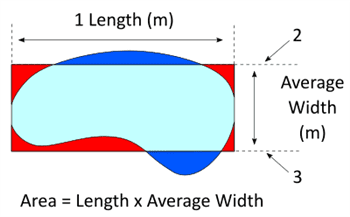
Alternatively, if you were happy with the level of heating your old PVC tube system produced and want the equivalent amount, use 2/3rds the panel area of your old rubber collector mat system, so for example if your old PVC tube system was 30sqm, use ~20 panels. This can be used as a cross check for our sizing, however please note typically if your old strip system was professionally installed they may have up sized it above the Aus Standard sizing. Installers will typically do this for PVC strips as it's easy and cheap enough to put down and they don't want to come back due to a customer complaining about an under performing system.
3) System Plumbing Options
Next thing to Consider what kind of plumbing system you want to set up. We always recommend Independent Systems, see definitions below or manual. These systems run a small independent pump, typically for 8 hours per day and are actually more energy efficient than systems running through the main filter pump which have to run the large filter pump for 8 hours per day just to pump the solar side. Of course independent systems require separate solar suction and return lines, whereas for older pool these might not have been installed. If that's the case you'll need to go with a plumbing configuration that taps into your existing filter return line to divert water to your roof. There are a few configurations that can be chosen, see below or manual. Most people that do not have independent solar suction and return ports will choose a Manual/Timer System and place the main filter pump on a timer to run during the warmest part of the day. These manual systems can be automated down the track. We have three class of listings:
- "Automatic Kit" - can be used to set up an Independent System or Integrated-Independent System - includes a solar controller (pump sold separately)
- "Manual Kit" - runs through the filter lines, can be used to set up a Manual/Timer System with a 3-way and non-return PVC ball valve (can be motorized/automated later)
- or just collector "Replacement Kit" - for people that just need to replace their old PVC tube collectors on the roof
If you need to set up a specialized system like for a Booster/Retro Fit System (requires AquaSmart 5 FS or CD controller) or the Motorized Ball Valve System (requires AquaSmart 5 AV controller), please contact us at EcoOnline.



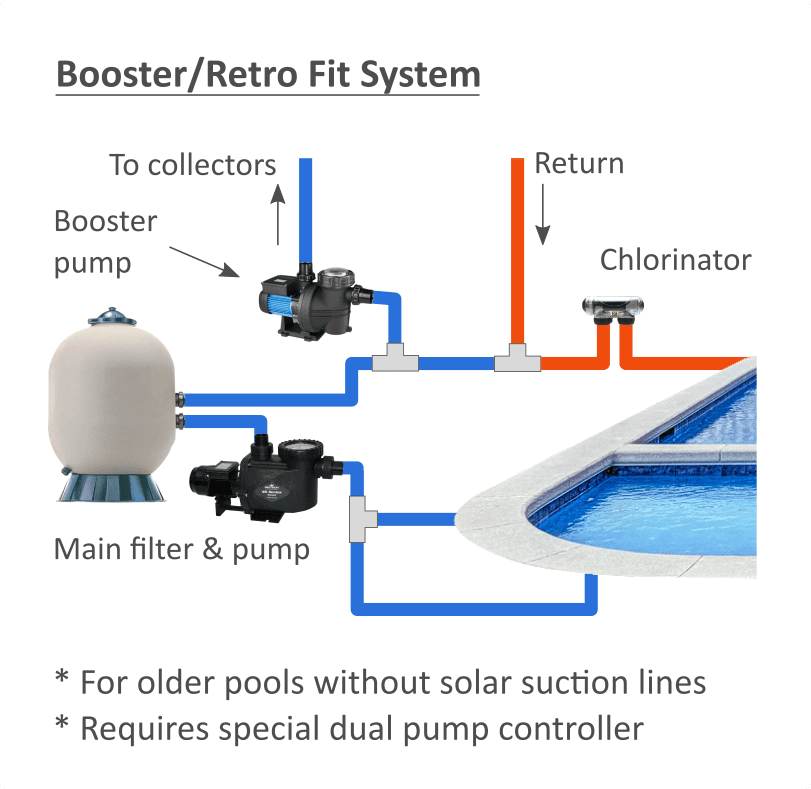
4) Roof Mounting Options and Panel Specifications
In terms of roof mounting, panels are simply strapped down around their 40mm header pipes to aluminium channels top and bottom using the 6 supplied 316 stainless metal straps. The aluminium channels need to be fixed down by screwing through into battens or rafters. Tile installations are more involved using solar roof hooks that are screwed into rafters and have a protruding external under tile arm/hook that holds the aluminium channels top and bottom on the roof. Dual header panels join end to end horizontally across the roof in a single row (or two or three rows). It's even possible to mount panels on their sides; such that the short side runs up the roof. See manual for full description.

5) Wind Loading Considerations
In terms of wind loadings on panels our roof fixing methodology is the highest in it's class up to wind region C. See manual for full description. We like to take a cautious over-engineered approach to wind loadings and suggest installers do the same as it's very easy to put down more fixings. However, there are some cases where we can't recommend panels over tubes due to high wind loadings (if in doubt please as ask). As a guide please note the following recommendations:
7) Available Extras (upon request)
304 Stainless Solar Roof Hooks for Tiles (height adjustable)
Dimensions: A = 47.5mm, B = 112mm, C = 60mm
Available on request for $8.50 each.Please note: if you have tiles need solar roof hooks please contact us as we need to work out how many you'll need to use.

8) Shipping Cost & ETA Estimate
For a shipping estimate, use the above calculator or just add this listing to your cart and click "View Cart" at the top right of this page, then "Estimate Shipping" on the cart page. The shipping estimated time of arrival (ETA) can be checked on our shipping calculator here. We ship from Melbourne Victoria.
9) Safety Requirements and Product Limitation Considerations
- Warning: Due to the potential of falling from heights, mounting the solar panels on a roof or structure at heights should only be undertaken by a professional solar panel installer, unless you are accustomed to and confident of performing the work.
- For ground level collectors the installer MUST check child safety fence regulations in the relevant state. Under no circumstances should collectors be installed so as to compromise the effectiveness of a child pool or spa fence safety barrier by providing a climbable object.
- At present this collector array system is not recommended for installations in cyclonic regions C (sheltered only) or D, or on houses situated on top of hills exposed to strong winds, or on second story (or higher) roofs due to the danger of getting up on these roofs. Installations on tiles are for Wind Region A only.
- Collectors are to be used with chlorinated (or otherwise treated) pool water ONLY. Do not use collectors to heat fresh (untreated) water due to the potential for Legionaries bacteria build up.
- We recommend collectors be installed with a minimum 2 degree pitch to ensure reliable evacuation of air bubbles.
- Collectors must be installed such that they drain fully in hot weather - collectors must not be installed below the waterline of the pool.
Gallery of Installations



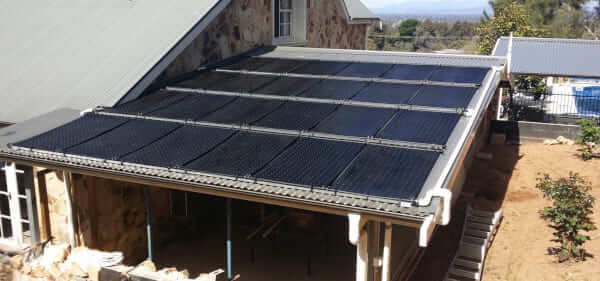

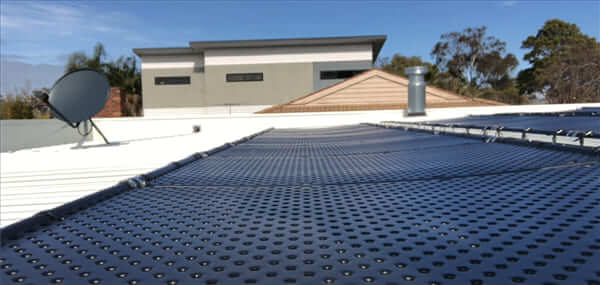


Frequently Asked Questions (FAQs)
Q. How large are the panels?
A. You should budgett a gross panel dimension of approx 140cm in length and 85cm in pipe to pipe width or about 1.2sqm per panel.
Q. How many panels do I need?
A. Please use our interactive sizing calculator to accurately size your panel needs, if you have any difficulty please contact us. Note: we frown upon the practice of selling you more panels than what you actually need for your heating goals - to back our smaller sizing recommendation we provide a panel sizing guarantee.
Q. I was sized a much larger rubber mat system - why is your panel area recommendation smaller?
A. Besides the increased efficiency in cooler weather during critical season extension months - we absolutely frown upon the industry practice of selling you a larger system. The Australian Standard 3634-1989 for sheltered pools only recommends 60% (rubber strip) coverage in southern regions, 50% for mid regions, and 40% for northern regions. Over-sizing a system will result in polymer collectors stagnating at detrimental temperatures of up to 80˚C for longer periods during hot days when the controller shuts the system down. As such over-sizing reduces collector lifetimes requires a larger pump and higher upfront costs – all for diminishing gains in water temperature. If you require higher temperatures beyond our maximum collector recommendation we recommend a solar blanket.
Q. Can I undersize my system and upgrade as needed later?
A. Yes, but only to an extent. You should not go below our minimum 2 month extension recommendation, see our interactive sizing calculator. No - we are not trying to sell you a larger system. There are very good reasons why a system should not be dramatically undersized. Effective heating requires a minimum daily turnover typically 50% of your pool water volume. However, there are flow limitations on panels; hence an undersized system may not handle the flow required which could over-pressurize panels or if the flow is insufficient, will result in an unmixed stratified layer of warm water which will cool excessively overnight.
Q. Can I use my existing controller and mains power pump?
A. You can use your existing controller and filter pump if it’s in good working order.
Q. Can I use a low energy usage variable speed pump?
A. No, after witnessing customers try such pumps and struggle with them our advice now is not to use them, unless they can be set to run at a constant speed without a startup surge. We find variable pumps start at full power then taper back, this puts a lot of pressure fluctuations through the panels on startup which could limit panel lifetimes. We only recommend pumps that can pump at a constant set pressure.
Q. Do we have installers?
A. At present unfortunately no we do not have installers as we ship around Australia. However, our manuals are very comprehensive and cover most situations and issues. There is also unlimited tech support available. Most handymen/tradespeople can install our systems. From what we hear, solar pool heating installs are very seasonal, hence most specialist pool heating installers are run off their feet during the install season, this means they charge an arm and a leg for poor rushed installs. Our advice is if you can DIY safely or source a trusted installer that will take his/her time, you will save a great deal of money and headaches.
Q. Can I download your comprehensive manual before I purchase?
A. Yes, in fact we highly recommend you check over the manual to get a good idea of installation requirements before you purchase. The manual can freely be downloaded from our EcoOnline download page.
Q. Is this system easy to install for tiles?
A. Installation on tiles is more difficult and we recommend should only be attempted by experienced DIY or tradespersons.
Q. Can I slow the flow to increase the temperature gain?
A. No, this is a common misconception. Slowing the water flow will result in a warmer outlet but also less harvested energy overall since there is much less warm water flowing. This is because the panel is being made to work at a higher temperature and hence a lower efficiency. Faster flow rates better strip the heat from the panels (up to a point of diminishing benefit). Optimal flow rate is achieved at 5-10L/min/panel. Over-sizing flow rates beyond 10L/min/panel will not provide more heating but can have a detrimental effect on the panels due to over-pressurization depending on the back pressure determined by the number and size of the eyelet returns to your pool.













